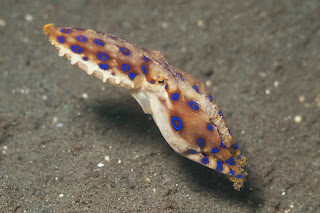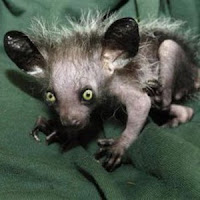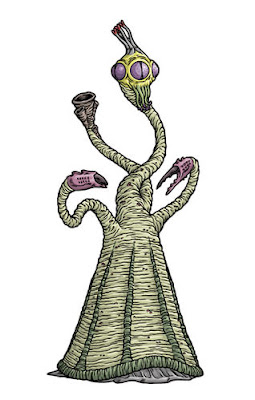During the previous session of the game I'm running, my players had a very odd OOC discussion about “weaponized newts". I told them I might write that up... so I did.
 |
| Buckle in for some pictures of amphibians. They're adorable and you can't convince me otherwise. (Source) |
Clamorous Newt
An amphibian small enough to hold in one's hand, with sharp teeth and an exceptionally large mouth over a bulging air-sac.
CR 1; XP 400
Neutral Diminutive Aberration
Init +2; Senses low-light vision, Perception +1
Init +2; Senses low-light vision, Perception +1
⸻Defense⸻
AC 15, touch 15, flat-footed 13 (+3 size, +2 Dex)
hp 13 (2d8+4)
Fort +2, Ref +2, Will +3
⸻Offense⸻
Speed 10ft, swim 20ft
Melee bite +2 (2d4-4)
Special Attacks clamor 6/day
⸻Statistics⸻
Str 3, Dex 15, Con 14, Int 2, Wis 12, Cha 2
Base Atk +0; CMB +0; CMD 4
Feats Weapon Finesse
Skills Stealth +4
⸻Special Abilities⸻
Clamor (Ex): Six times a day, a Clamorous Newt can emit a 10-foot cone of focused sound from its enlarged throat. Anyone caught in the cone takes 2d6 sonic damage and is deafened for the next hour. A successful Fortitude save (DC 12, Con-based) halves the damage, and the target is dazed for 1 round rather than deafened for 1 hour.
⸻Ecology⸻
Environment aquatic or coastal
Organization solitary or pair
Treasure none
Organization solitary or pair
Treasure none
 |
| Newt! |
Description
Hundreds of millions of years ago, the aboleths were masters of the world, and shaped many of its inhabitants to suit their needs. The Clamorous Newt is a minor bit of detritus from that era of prehistory -- an early amphibian1, modified to act as a small personal weapon. Exactly why the need for such a thing arose, considering the powers the aboleths had at their command, is unclear, but here we are.
Though the Clamorous Newt has only animal intelligence, it is mildly telepathic. It also retains its ancestral memory that it is meant to ride along on a more intelligent creature and follow their orders; a sufficient effort of will can convince one that you are its master, and it will behave like a loyal pet -- a loyal pet that can also be commanded to deafen one's enemies. It usually insists on riding on the shoulder (or similar) of its “master", and will obey simple telepathic commands. So long as you maintain the bond with a Clamorous Newt -- by feeding it often and having it remain near you -- it will not be possible for anyone else to form a bond with it; the “effort of will" trick only works on Newts who are not loyal to anyone at the time. The terrible exception, however, is the aboleths. It rarely comes up, of course, but an aboleth can take control of any Clamorous Newt within several yards, as an inherent loyalty to the aboleth species is built into the Newts at a fundamental level.
Bonding with a Clamorous Newt
In order to convince a Clamorous Newt that you are its master and not, for example, something it should be clamoring at, you must roll under your Intelligence score while standing within five feet of it. This will only work on a wild Clamorous Newt -- one that already has a master is unshakably loyal. If you fail your roll, you cannot try again that day. If you already have a Clamorous Newt bonded to you, you take a penalty of +1 to the roll,2 as thinking at two of them at the same time requires slightly more focus; this effect stacks. A bonded Newt will obey telepathic commands, but nothing too complex -- they're slightly less intelligent than your average dog. The bond can erode if the Newt feels mistreated; if the GM feels that you are not giving it enough tasty mollusks or putting it in excessive danger, there is a chance that it will simply wander off. This chance is represented by a reroll of the original check to bond with it; a failed check means the Newt leaves, and a successful check means that it stays. These checks can be rolled daily if you do not start treating your Newt better. Try giving it a nice shrimp. In addition, the Newt might sever its bond with you if it thinks you have left it; for each day you are more than a mile away from your Newt, you must reroll your check.
Wild Clamorous Newts are not uncommon in certain coastal areas; after they were abandoned by the aboleths, the Newts still had the advantages of being able to tolerate saltwater -- most amphibians can't, but the aboleths needed something that didn't mind being in the ocean -- and a powerful natural weapon. They have spread to fill a number of ecological niches throughout the oceans, and are generally doing well for themselves. Having been allowed to “grow wild" for a few hundred million years has also given them enough time to split into many different species and subspecies, and in recent centuries, some of the weirder segments of upper-crust society have developed groups of “newt fanciers", who breed the creatures for ever-more-outré traits in an attempt to outdo their peers. For these reasons, a proper description of the Clamorous Newt requires use of the included table on the traits possessed by newts of that particular species, subspecies, or bespoke breed.
 |
| Makes a heck of a lot more sense than “pigeon fanciers". |
d100 table -- “Yeah, But MY Newt..."
Roll 1d4 times for a given Clamorous Newt or (sub-)species thereof. For a particularly unusual specimen that might be displayed by a newt fancier, roll 2d4 times.
- Bites like hell; will attack anything in reach other than its master.
- Can break glass or crystal with its Clamor.
- Can cause permanent deafness with its Clamor.
- Can change color like a chameleon.
- Can create hypnotic patterns on its skin.
- Can croak like a frog.
- Can echolocate.
- Can form hive-minds with other Clamorous Newts (does not work if the Newts are bonded to two different people).
- Can generate an electric shock; 1d4 damage, touch only.
- Can glide through the air on skin flaps.

Image source. - Can hiss like a snake.
- Can jump several feet in the air.
- Can see in the dark; replace low-light vision with darkvision.
- Can see into the infrared.
- Can see into the ultraviolet.
- Can shoot its tongue out of its mouth to catch insects.
- Can spit jets of water with frightening precision; 10ft range, 1 damage.
- Can spit mucus ten feet.
- Has a boomerang-shaped skull that protrudes on either side of its body.

Art by Dmitry Bogdanov. - Can squeak like a mouse.
- Can track prey by body heat.
- Can walk up walls.
- Digs a lot; add a burrow speed of 5 ft.
- Doesn't sleep.
- Engages in parrot-like mimicry.
- Feeds by sucking the blood out of its prey.
- Generates infrasound; instead of deafening or dazing targets, its Clamor has an effect like that of cause fear.
- Has a crest along its back.

Art by Nobu Tamara. - Has a forked tail.
- Has a large, bulbous head.
- Has a large, flat, paddle-shaped tail; double swim speed.
- Has a neck frill.
- Has a parasitic relationship with a larger sea creature, and spends most of its time attached to its host.
- Has a sense of smell like a bloodhound.
- Has a tail at least twice the length of its body.
- Has a long, thin, gharial-esque jaw.

Image source. - Has a taste for human(oid) flesh. Watch your fingers.
- Has alligator-like bony plating; +3 natural AC.
- Has an especially high-pitched tone; the area of effect of its Clamor is a 20-foot line.
- Has an especially low-pitched tone; the area of effect of its Clamor is a 5-foot radius.
- Has an expandable stomach and swallows things many times its own size.
- Has an extra head.
- Has an extra minor magical ability; pick a 0-level spell off the Sorcerer/Wizard spell list at random; it's a 1/day spell-like ability.
- Has an extra pair of eyes.
- Has an extra pair of legs.
- Has an extra tail.
- Has bulging eyes.
- Has developed a particularly complex skin pattern.
- Has fiendish blood.
- Has celestial blood.
- Has long, feathery external gill stalks. Look at the pretty little guy!

Image source. - Has horns.
- Has long legs; double speed.
- Has long, webbed digits; double swim speed.
- Has no sense of loyalty and might attack at any time.
- Has particularly big eyes.
- Has scales; +1 natural AC.
- Has sharp claws. Rar! (Add two 1-damage claw attacks.)
- Has spines; add a melee attack for 1d4 damage.
- Has the Ability Focus feat.
- Inflates like a blowfish.
- Has transparent flesh.
- Has very long fangs; increase bite damage by one die type.
- Has very thick scales; +2 natural AC.
- Has wee tentacles on either side of its mouth.
- Is albino.
- Is all warty.
- Is from a cave-dwelling subspecies and has evolved beyond the need for eyes. (No vision, but gain the Blind-fight feat.)

Image source. - Is bioluminescent.
- Is bioluminescent and can flash complicated light-shows on its skin.
- Is bioluminescent and slightly magical; casts light on itself 3/day as a spell-like ability.
- Is especially long and thin, like a snake. Or a shoelace.
- Is extra friendly.
- Is extra slimy.
- Is from a legless subspecies. Look at it slither!

Image source. - Is highly social; always encountered in groups of four or more.
- Is incredibly poisonous. With patience and care, one can collect enough of its skin secretions to make one dose of Newt Poison each day. (Newt Poison, which is more poisonous to people than it is to newts, is administered by ingestion. Fort DC: 12, onset: 10 minutes, frequency: 1/minute for 10 minutes, effect: 1d4 Str, cure: 2 saves.)
- Is of an especially striking hue.
- Is from a neotenous subspecies; under the right conditions, it might metamorphose into a forgotten "adult" form that is larger and more dangerous.

Much like an axolotl. - Is particularly attentive; +2 Perception.
- Is particularly loud; add 1d6 to Clamor damage and increase the save DC by 2.
- Is segmented like an earthworm.
- Is silent; Clamor deals force damage rather than sonic, and always dazes rather than deafens.
- Is technically more of a frog; double its move speed on land.
- Is unusually large; increase size category by one.

Image source. - Is unusually fast; increase Dex by 2.
- Is unusually smart; increase Int by 2.
- Is unusually strong; increase Str by 2.
- Is unusually tough; increase Con by 2.
- Is unusually small; decrease size category by one. Tiny baby!

Image source. - Is venomous; can use its fangs to inject Newt Poison.
- Is very vocal, and mutters to itself constantly.
- Makes complex whistling noises.
- Secretes awful-smelling muck when disturbed.
- Secretes hallucinogens. Wanna lick?
- Sings like a tree-frog.
- Spits acid; 10-ft range, 1d4 damage.
- Stings if you touch it; 1d4 damage.
- Uses rippling fins on the side of its body to swim around.
- Roll twice and combine; reroll contradictions.

Newts!
1. Which means Clamorous Newts aren't technically newts; their creation was fairly early in the evolutionary history of the amphibians, and therefore they may have since speciated into forms that resemble any sort of extant or extinct amphibian that you care to name. I like the idea of them looking like newts, but you could make them more frog-like if you want... or, you know, caecilians don't get nearly as much press as they deserve.
2. It feels weird to write “penalty of +1", but I really want to bring back the “roll under" mechanic.
















